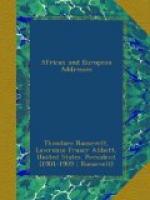Similarly, “extinction of species” is a term which has two entirely different meanings. The type may become extinct by dying out and leaving no descendants. Or it may die out because as the generations go by there is change, slow or swift, until a new form is produced. Thus in one case the line of life comes to an end. In the other case it changes into something different. The huge titanothere, and the small three-toed horse, both existed at what may roughly be called the same period of the world’s history, back in the middle of the mammalian age. Both are extinct in the sense that each has completely disappeared and that nothing like either is to be found in the world to-day. But whereas all the individual titanotheres finally died out, leaving no descendants, a number of the three-toed horses did leave descendants, and these descendants, constantly changing as the ages went by, finally developed into the highly specialized one-toed horses, asses, and zebras of to-day.
The analogy between the facts thus indicated and certain facts in the development of human societies is striking. A further analogy is supplied by a very curious tendency often visible in cases of intense and extreme specialization. When an animal form becomes highly specialized, the type at first, because of its specialization, triumphs over its allied rivals and its enemies, and attains a great development; until in many cases the specialization becomes so extreme that from some cause unknown to us, or at which we merely guess, it disappears. The new species which mark a new era commonly come from the less specialized types, the less distinctive, dominant, and striking types, of the preceding era.
When dealing with the changes, cataclysmic or gradual, which divide one period of palaeontological history from another, we can sometimes assign causes, and again we cannot even guess at them. In the case of single species, or of faunas of very restricted localities, the explanation is often self-evident. A comparatively slight change in the amount of moisture in the climate, with the attendant change in vegetation, might readily mean the destruction of a group of huge herbivores with a bodily size such that they needed a vast quantity of food, and with teeth so weak or so peculiar that but one or two kinds of plants could furnish this food. Again, we now know that the most deadly foes of the higher forms of life are various lower forms of life, such as insects, or microscopic creatures conveyed into the blood by insects. There are districts in South America where many large animals, wild and domestic, cannot live because of the presence either of certain ticks or of certain baleful flies. In Africa there is a terrible genus of poison fly, each species acting as the host of microscopic creatures which are deadly to certain of the higher vertebrates. One of these species, though harmless to man, is fatal to all domestic animals, and this although harmless to the closely-related




